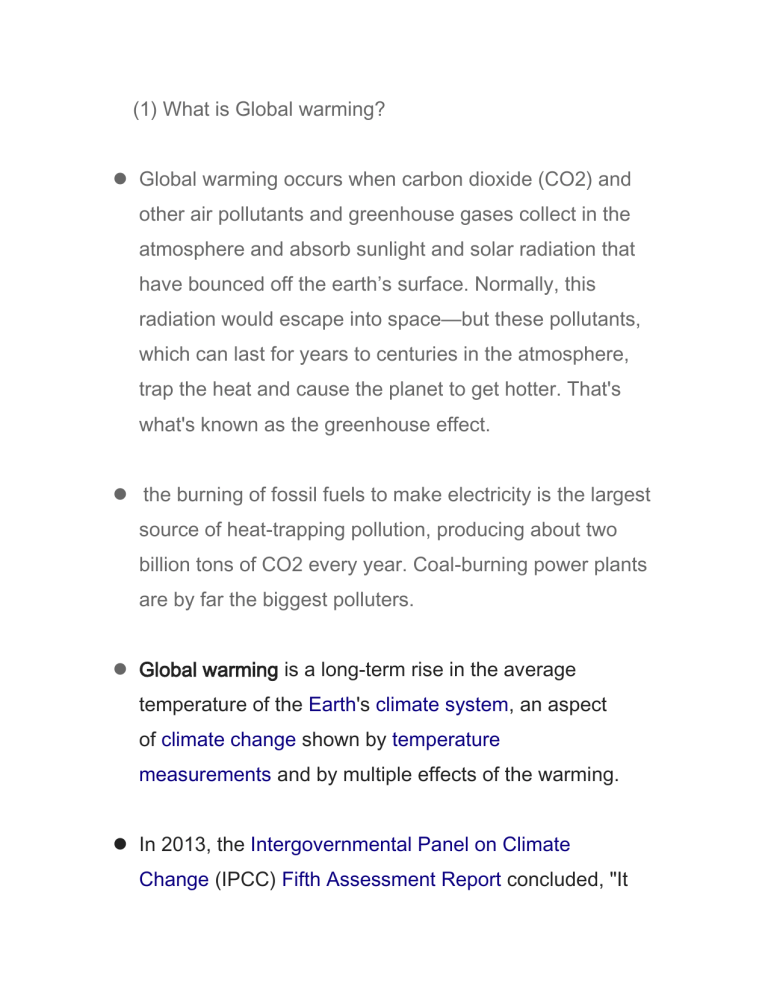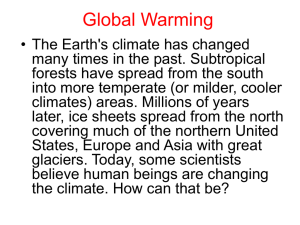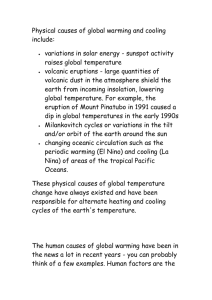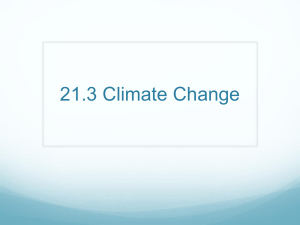
(1) What is Global warming? Global warming occurs when carbon dioxide (CO2) and other air pollutants and greenhouse gases collect in the atmosphere and absorb sunlight and solar radiation that have bounced off the earth’s surface. Normally, this radiation would escape into space—but these pollutants, which can last for years to centuries in the atmosphere, trap the heat and cause the planet to get hotter. That's what's known as the greenhouse effect. the burning of fossil fuels to make electricity is the largest source of heat-trapping pollution, producing about two billion tons of CO2 every year. Coal-burning power plants are by far the biggest polluters. Global warming is a long-term rise in the average temperature of the Earth's climate system, an aspect of climate change shown by temperature measurements and by multiple effects of the warming. In 2013, the Intergovernmental Panel on Climate Change (IPCC) Fifth Assessment Report concluded, "It is extremely likely that human influence has been the dominant cause of the observed warming since the mid-20th century."[9] The largest human influence has been the emission of greenhouse gases such as carbon dioxide, methane, and nitrous oxide. In view of the dominant role of human activity in causing it, the phenomenon is sometimes called "anthropogenic global warming" or "anthropogenic climate change". Carbon-dioxid9(CO2), methane, nitrous oxide, ozone(O3) are main gasses. of average of temprature. Its a natural event but we human are also contributing to increasein avrage temprature through our other activites. (2) Causes There are two types 1) natural 2) human influences on global warming NATURAL The climate has continuously changing for centuries. The global warming happens because the natural rotation of the sun that changes the intensity of sunlight and moving closer to the earth. Volcanic eruptions Another cause of global warming is greenhouse gases. Greenhouse gases are carbon monoxide and sulphur dioxide it trap the solar heats rays and prevent it from escaping from the surface of the earth. This has cause the temperature of the earth increase. Finally, methane is another issue that causes global warming, its also a greenhouse gas. Methane is more effective in trapping heat in the atmosphere that carbon dioxide by 20 times. Usually methane gas can release from many areas. For instance, it can be from cattle, landfill, natural gas, petroleum systems, coal mining, mobile explosion, or industrial waste process. Human influences on global warming Deforestation or cattle rearing Landfills Population Industrial revolution Burning fossil fules Water waste Greenhouse effects Deforestation or cattle rearing Conversion of forests for other land uses. Forest fires Illegal and unsustainable logging: Illegal logging occurs in all types of forests across all continents. Fulewood harvesting Mining Climate change (natural & human effects) Landfills Landfills are sites designated for dumping rubbish, garbage, or other sorts of solid wastes. Solid waste Agricultural waste Industry, manufacturing and construction waste Population growth Urbanization Rapid increase in urbanization over that years has filled up the landfills. Plastics and all sorts of toxins are a part of urbanization which is indeed dumped in the nearby landfills. Population Overpopulation is an undesirable condition where the number of existing humanpopulation exceeds the carrying capacity of Earth. Overpopulation is caused by number of factors. Reduced mortality rate, better medical facilities, depletion of precious resources are few of the causes which results in overpopulation. Immigration Lack of family planning Industrial revolution Population growth Political and economical competition Innovation and new technology Easy Transport systems Burning fossil fuels A fuel which burns completely in the air at a moderate rate and produces a large amount of energy is known as an ideal fuel. Carbon fuels such as wood, coal, petroleum release unburnt carbon particles in the environment. When fuels are incompletely burnt, they release carbon monoxide gas into the atmosphere. The combustion of fossil fuels also releases a large amount of carbon dioxide into the atmosphere. Carbon dioxide is a greenhouse gas which is responsible for global warming. Burning of coal and diesel releases sulphur dioxide gas. This gas is extremely corrosive and suffocating in nature. Petrol gives off oxides of nitrogen. The oxides of sulfur and nitrogen get dissolved in rainwater and form acids. This is known as acid rain. This water is very harmful to plants, animals, and various monuments. Water waste Humans are the main cause of water pollution, which is triggered in many ways: oil refinery or hauling ship that contributed a massive amount of pollution within a single area. Dumping of industrial waste; due to temperature rise, that cause the alteration of water by reducing the oxygen in its composition. Deforestation the pesticides used in agricultural fields filter through underground channels and reach the consumption networks. And also as a result of accidental spillage of oil. Once water becomes polluted it becomes unsafe for consumption due to the dangerous or toxic materials that are contained within the water. Greenhouse Effects Greenhouse gases warm the atmosphere by absorbing some of the thermal radiation emitted from the Earth's surface. Some of the thermal radiation is absorbed by the greenhouse gases instead of being re-transmitted out to space, and so there is a warming of the atmosphere. carbon dioxide (CO2), methane (CH4), nitrous oxide (N2O), chlorofluorocarbons (CFCs) and ozone. Water vapour is also an important greenhouse gas. The main effects caused by the rise in the greenhouse gases are droughts, flooding, melting of snow, extreme weather conditions, natural calamities, rising sea level. Amount of greenhouses gasses has been increased due to deforestation, burning fossil fuels, landfills, water waste etc. The Industrial Revolution has resulted in an increase in the concentration of CO2 in the atmosphere of about 30% Increased amounts of greenhouse gases in the atmosphere will absorb more thermal radiation, and the Earth's surface and the lower atmosphere will warm. This extra warming is called the enhanced greenhouse effect. Effects Hotter days In the past few years records have being broken for longest heatwaves and the Bureau of Meteorology has added purple and magenta to the forecast map for temperatures up to 54°C. The Earth's temperature had already warmed by 1°C compared to pre-industrial levels. Rising sea level Increased ocean temperatures are melting glaciers and ice caps all over the world. Melted ice increases the volume of water in our oceans. Warmer temperatures also result in the expansion of the water's mass, which causes sea levels to rise, threatening low-lying islands and coastal cities. More frequent and intense extreme weather events Extreme weather events like bushfires, cyclones, droughts and floods are becoming more frequent and more intense as a result of global warming. Oceans are warming and acidifying The oceans have absorbed most of extra heat and carbon dioxide (CO2) so far – more than the air – making the seas both warmer and more acidic. Warming waters are bleaching coral reefs and driving stronger storms. Rising ocean acidity threatens shellfish, including the tiny crustaceans without which marine food chains would collapse. Ecosystems Global warming stresses ecosystems through temperature rises, water shortages, increased fire threats, drought, weed and pest invasions, intense storm damage and salt invasion. Food and farming Changes to rainfall patterns, increasingly severe drought, more frequent heat waves, flooding and extreme weather make it more difficult for farmers to graze livestock and grow produce, reducing food availability and making it more expensive to buy. Health Mosquito-borne diseases are probably the greatest threat to humans as they include malaria, elephantiasis, Rift Valley fever, yellow fever, and dengue fever, skin diseases etc. Coral bleaching Rising temperatures and acidity within our oceans is contributing to extreme coral bleaching events, like the 2016 event that destroyed more than one-third of the Great Barrier Reef. Water Reduced rainfall and increasingly severe droughts may lead to water shortages. Conclusion Plant trees Planting trees can help much in reducing global warming then any other method. They not only give oxygen but also take in carbon dioxide, during the process of photosynthesis, which is the main source of global warming. Go solar Reduce water waste Drive a fuel-efficient vehicles You can offset the carbon you produce by purchasing carbon offsets Save energy Become Aware of Your Contribution With technology within your fingertips, finding information about protecting the environment is everywhere. To help emit less CO2, the first step is being aware of how much you contribute. Spread the Awareness Always try your best to educate people about global warming and it’s causes and after affects. Tell them how they can contribute their part by saving energy that will be good for the environment. THE END






